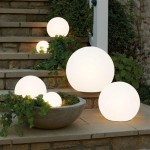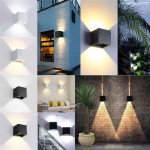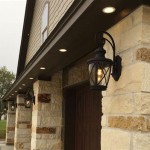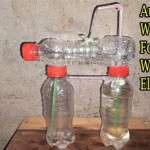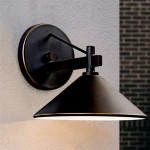Outdoor Solar Light Parts: A Comprehensive Guide
Outdoor solar lights are becoming increasingly popular for their eco-friendly nature and cost-effectiveness. These lights harness the power of the sun to illuminate pathways, decks, gardens, and other outdoor spaces. Understanding the various parts that make up a solar light system can help you choose the right setup for your needs and ensure optimal performance.
Solar Panel
The solar panel is the heart of any outdoor solar light system. It is responsible for converting sunlight into electrical energy. Solar panels are typically made of photovoltaic (PV) cells, which are semiconductor materials that generate electricity when exposed to light. The size and efficiency of the solar panel determine the amount of energy it can capture and store.
Factors to consider when choosing a solar panel include:
- Size: Larger panels capture more sunlight, leading to greater power output.
- Efficiency: Panels with higher efficiency convert a larger percentage of sunlight into electricity.
- Orientation: Properly orienting the panel towards the sun maximizes energy production.
- Material: Solar panels are often made of monocrystalline or polycrystalline silicon.
Battery
The battery stores the energy generated by the solar panel for later use. When the sun is not shining, the battery powers the light fixture. The type and capacity of the battery determine how long the light can operate before needing to recharge.
Common battery types used in outdoor solar lights include:
- Nickel-Cadmium (Ni-Cd): These batteries are durable and can withstand extreme temperatures but have a lower energy density.
- Nickel-Metal Hydride (NiMH): NiMH batteries offer higher energy density than Ni-Cd, but they are less durable and may degrade faster in extreme temperatures.
- Lithium-ion (Li-ion): Li-ion batteries are known for their high energy density, long lifespan, and light weight. However, they can be more expensive than other types.
The battery capacity is measured in amp-hours (Ah), which indicates how much energy it can store. A larger battery capacity will provide longer runtime, but it will also be heavier and more expensive.
Light Fixture
The light fixture houses the LED lamp and provides the desired illumination. The type of fixture depends on the specific application. Common fixtures include:
- Path lights: Designed to illuminate walkways and pathways, these fixtures are typically small and low-profile.
- Spotlights: These fixtures provide focused beams of light and are ideal for highlighting specific features or areas.
- Floodlights: Floodlights emit a wide beam of light, making them suitable for illuminating larger areas.
- String lights: String lights consist of multiple bulbs connected together and are often used for decorative purposes.
Factors to consider when choosing a light fixture include:
- Brightness: Measured in lumens, brightness determines the intensity of the light.
- Color temperature: This refers to the color of the light emitted, measured in Kelvin (K). Warm white (2700-3000K) is ideal for creating a cozy atmosphere, while cool white (4000-4500K) provides brighter illumination.
- Durability: Outdoor fixtures should be weatherproof and resistant to corrosion.
- Design: Choose a fixture that complements the style of your outdoor space.
Controller
The controller manages the flow of energy within the solar light system. It regulates the charging and discharging of the battery, as well as the operation of the light fixture. Some controllers offer additional features, such as dusk-to-dawn operation, motion sensing, and timer settings.
Wiring and Connections
All the components of a solar light system are connected via wiring. The solar panel is typically wired to the controller, which in turn is wired to the battery and the light fixture. It is essential to use appropriate wiring and connectors to ensure safe and efficient operation.
Other Essential Components
In addition to the core parts, some solar light systems may include other components, such as:
- Mounting bracket: This secures the solar panel to the desired location.
- Ground stake: Used to secure the light fixture to the ground.
- Switch: Some solar lights have a switch to turn them on and off manually.
Understanding the individual parts of an outdoor solar light system is crucial for making informed purchasing decisions and ensuring proper installation and maintenance. By considering the factors discussed above, you can select the most appropriate components for your needs and enjoy the benefits of energy-efficient and reliable outdoor lighting.

5 Pack Replacement Solar Light Parts Top Size 2 76 Inches Bottom 36 7 Lumens Warm White Led Waterproof Lazada Singapore

Hzewls Replacement Solar Light Tops Outdoor Hanging Lantern Parts 2pcs Com

Replacement Solar Light Parts Top Size Bottom Warm White Led Waterproof Kit For Outdoor Diy Hanging Lanterns Garden Patio Decor Up Your Space

Parts Solar Light Human Sensor Garden Wall Sconce Ground Plug Lighting Small Floor Lamp

Replacement Solar Light Parts Top Size Bottom Warm White Led Waterproof Kit For Outdoor Diy Hanging Lanterns Garden Patio Decor Up Your Space

4pcs Replacement Solar Light Tops Outdoor Hanging Lantern Parts Round Lights Waterproof Decorative For Lanterns 2 8 Inch In Diameter Com

Replacement Solar Light Tops Outdoor Hanging Lantern Parts Round Lights Waterproof Decorative For Lanterns Temu Cyprus

4 Pieces Replacement Solar Light Tops Outdoor Hanging Lantern Parts Round Lights Waterproof

3x 1 Pack Big Solar Light Replacement Top For Outdoor Hanging Lanterns More Pow

4pcs Replacement Solar Light Tops Outdoor Hanging Lantern Parts Round Lights Waterproof Decorative For Lanterns 3 4 Inch In Diameter Com
Related Posts

